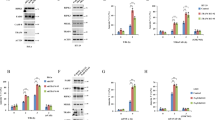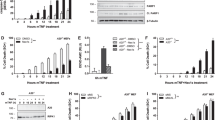Abstract
The proinflammatory cytokine tumour necrosis factor-α (TNF-α) regulates immune responses, inflammation and programmed cell death (apoptosis)1,2,3,4. The ultimate fate of a cell exposed to TNF-α is determined by signal integration between its different effectors, including IκB kinase (IKK), c-Jun N-terminal protein kinase (JNK) and caspases1. Activation of caspases is required for apoptotic cell death5, whereas IKK activation inhibits apoptosis through the transcription factor NF-κB, whose target genes include caspase inhibitors1,6,7,8,9,10. JNK activates the transcription factor c-Jun/AP-1, as well as other targets11,12,13,14,15,16. However, the role of JNK activation in apoptosis induced by TNF-α is less clear17,18. It is unknown whether any crosstalk occurs between IKK and JNK, and, if so, how it affects TNF-α-induced apoptosis. We investigated this using murine embryonic fibroblasts that are deficient in either the IKKβ catalytic subunit of the IKK complex or the RelA/p65 subunit of NF-κB. Here we show that in addition to inhibiting caspases, the IKK/NF-κB pathway negatively modulates TNF-α-mediated JNK activation, partly through NF-κB-induced X-chromosome-linked inhibitor of apoptosis (XIAP)7,9. This negative crosstalk, which is specific to TNF-α signalling and does not affect JNK activation by interleukin-1 (IL-1), contributes to inhibition of apoptosis.
This is a preview of subscription content, access via your institution
Access options
Subscribe to this journal
Receive 51 print issues and online access
$199.00 per year
only $3.90 per issue
Buy this article
- Purchase on Springer Link
- Instant access to full article PDF
Prices may be subject to local taxes which are calculated during checkout




Similar content being viewed by others
References
Baud, V. & Karin, M. Signal transduction by tumor necrosis factor and its relatives. Trends Cell Biol. 11, 372–377 (2001).
Tartaglia, L. A. & Goeddel, D. V. Two TNF receptors. Immunol. Today 13, 151–153 (1992).
Tracey, K. J. & Cerami, A. Tumor necrosis factor: an updated review of its biology. Crit. Care Med. 21, S415–S422 (1993).
Locksley, R. M., Killeen, N. & Lenardo, M. J. The TNF and TNF receptor superfamilies: integrating mammalian biology. Cell 104, 487–501 (2001).
Thornberry, N. A. & Lazebnik, Y. Caspases: enemies within. Science 281, 1312–1316 (1998).
Rothwarf, D. M. & Karin, M. The NF-κB activation pathway: a paradigm in information transfer from membrane to nucleus. Science STKE [online] (cited 26 October 1999) 〈http://www.stke.org/cgi/content/full/OC_sigtrans;1999/5/re1〉 (1999).
Duckett, C. et al. A conserved family of cellular genes related to the baculovirus iap gene and encoding apoptosis inhibitors. EMBO J. 15, 2685–2694 (1996).
Chu, Z. L. et al. Suppression of tumor necrosis factor-induced cell death by inhibitor of apoptosis c-IAP2 is under NF-κB control. Proc. Natl Acad. Sci. USA 94, 10057–10062 (1997).
Stehlik, C. et al. Nuclear factor (NF)-κB-regulated X-chromosome-linked iap gene expression protects endothelial cells from tumor necrosis factor alpha-induced apoptosis. J. Exp. Med. 188, 211–216 (1998).
Wang, C. Y., Mayo, M. W., Korneluk, R. G., Goeddel, D. V. & Baldwin, A. S. Jr NF-κB antiapoptosis: induction of TRAF1 and TRAF2 and c-IAP1 and c- IAP2 to suppress caspase-8 activation. Science 281, 1680–1683 (1998).
Chang, L. & Karin, M. Mammalian MAP kinase signalling cascades. Nature 410, 37–40 (2001).
Hibi, M., Lin, A., Smeal, T. & Karin, M. Identification of an oncoprotein- and UV-responsive protein kinase that binds and potentiates the c-Jun activation domain. Genes Dev. 7, 2135–2148 (1993).
Derijard, B. et al. JNK1: a protein kinase stimulated by UV light and Ha-Ras that binds and phosphorylates the c-Jun activation domain. Cell 76, 1025–1037 (1994).
Kyriakis, J. M. et al. The stress-activated protein kinase subfamily of c-Jun kinases. Nature 369, 156–160 (1994).
Lin, A. et al. Identification of a dual specificity kinase that activates the Jun kinases and p38-Mpk2. Science 268, 286–290 (1995).
Minden, A. et al. Differential activation of ERK and JNK mitogen-activated protein kinases by Raf-1 and MEKK. Science 266, 1719–1723 (1994).
Liu, Z. G., Hsu, H., Goeddel, D. V. & Karin, M. Dissection of TNF receptor 1 effector functions: JNK activation is not linked to apoptosis while NF-κB activation prevents cell death. Cell 87, 565–576 (1996).
Natoli, G. et al. Activation of SAPK/JNK by TNF receptor 1 through a noncytotoxic TRAF2-dependent pathway. Science 275, 200–203 (1997).
Hu, Y. et al. Abnormal morphogenesis but intact IKK activation in mice lacking the IKKα subunit of IκB kinase. Science 284, 316–320 (1998).
Li, Z. W. et al. The IKKβ subunit of IκB kinase (IKK) is essential for nuclear factor κB activation and prevention of apoptosis. J. Exp. Med. 189, 1839–1845 (1999).
Nemoto, S., DiDonato, J. A. & Lin, A. Coordinate regulation of IκB kinases by mitogen-activated protein kinase kinase kinase 1 and NF-κB-inducing kinase. Mol. Cell. Biol. 18, 7336–7343 (1998).
Beg, A. A., Sha, W. C., Bronson, R. T., Ghosh, S. & Baltimore, D. Embryonic lethality and liver degeneration in mice lacking the RelA component of NF-κB. Nature 376, 167–170 (1995).
Guo, Y-L., Kang, B & Williamson, J. R. Correlation between sustained c-Jun N-terminal protein kinase activation and apoptosis induced by tumor necrosis factor-α in rat mesangial cells. J. Biol. Chem. 273, 4027–4034 (1998).
Cavigelli, M., Li, W. W., Lin, A., Su, B., Yoshioka, K. & Karin, M. The tumor promoter arsenites stimulates AP-1 activity by inhibiting a JNK phosphatase. EMBO J. 15, 6269–6279 (1996).
Javelaud, D. & Besancon, F. NF-κB activation results in rapid inactivation of JNK in TNF-α-treated Ewing sarcoma cells: a mechanism for the anti-apoptotic effect of NF-κB. Oncogene 20, 4365–4372 (2001).
Sanna, M. G., Duckett, C. S., Richter, B. W., Thompson, C. B. & Ulevitch, R. J. Selective activation of JNK1 is necessary for the anti-apoptotic activity of hILP. Proc. Natl Acad. Sci. USA 95, 6015–6020 (1998).
Baud, V. et al. Signaling by proinflammatory cytokines: oligomerization of TRAF2 and TRAF6 is sufficient for JNK and IKK activation and target gene induction via an amino-terminal effector domain. Genes Dev 13, 1297–1308 (1999).
Chen, Y.-R., Wang, X., Templeton, D., Davis, R. & Tan, T.-H. The role of c-Jun N-terminal kinase (JNK) in apoptosis induced by ultraviolet C and gamma radiation. Duration of JNK activation may determine cell death and proliferation. J. Biol. Chem. 50, 31929–31936 (1996).
Lu, X., Nemoto, S. & Lin, A. Identification of c-Jun NH2-terminal protein kinase (JNK)-activating kinase 2 as an activator of JNK but not p38. J. Biol. Chem. 272, 24751–24754 (1997).
Zheng, C., Xiang, J., Hunter, T. & Lin, A. The JNKK2–JNK1 fusion protein acts as a constitutively active c-Jun kinase that stimulates c-Jun transcription activity. J. Biol. Chem. 274, 28966–28971 (1999).
Acknowledgements
We are grateful to D. Baltimore for providing us with RelA-/- fibroblasts and C. S. Duckett for the XIAP construct; M. R. Rosner for critical reading of this manuscript and suggestions; and S. Nemoto for her initial finding when she was a member of Lin laboratory. This work was supported by grants from the National Institutes of Health (NIH), the American Cancer Society (ACS) and Department of Defense to A.L. Generation of IKK-deficient cells was supported by grants from the NIH and State of California Cancer Research Program to M.K., who is the Frank and Else Schilling-ACS Research Professor.
Author information
Authors and Affiliations
Corresponding author
Supplementary Information
Rights and permissions
About this article
Cite this article
Tang, G., Minemoto, Y., Dibling, B. et al. Inhibition of JNK activation through NF-κB target genes. Nature 414, 313–317 (2001). https://doi.org/10.1038/35104568
Received:
Accepted:
Issue Date:
DOI: https://doi.org/10.1038/35104568
This article is cited by
-
Components of the JNK–MAPK pathway play distinct roles in hepatocellular carcinoma
Journal of Cancer Research and Clinical Oncology (2023)
-
Bcl-3 promotes TNF-induced hepatocyte apoptosis by regulating the deubiquitination of RIP1
Cell Death & Differentiation (2022)
-
The ERK5/NF-κB signaling pathway targets endometrial cancer proliferation and survival
Cellular and Molecular Life Sciences (2022)
-
Comprehensive high-throughput meta-analysis of differentially expressed microRNAs in transcriptomic datasets reveals significant disruption of MAPK/JNK signal transduction pathway in Adult T-cell leukemia/lymphoma
Infectious Agents and Cancer (2021)
-
FAM49B promotes breast cancer proliferation, metastasis, and chemoresistance by stabilizing ELAVL1 protein and regulating downstream Rab10/TLR4 pathway
Cancer Cell International (2021)
Comments
By submitting a comment you agree to abide by our Terms and Community Guidelines. If you find something abusive or that does not comply with our terms or guidelines please flag it as inappropriate.



